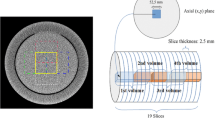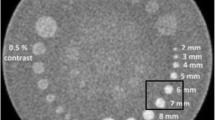Abstract
This study aims to evaluate the effect of pre-reconstruction process for low tube voltage computed tomography (CT) on image quality of filtered back projection (FBP) reconstruction. Small and large quality assurance water phantoms (19 and 33 cm diameter) were scanned on a third-generation dual-source CT with 70 kVp and 120 kVp at various dose levels. Image quality was assessed in terms of the noise power spectrum (NPS) and task-based transfer function (TTF). NPSs and TTFs in the small phantom were comparable between 70 and 120 kVp protocols. In the large phantom, the curves of the NPS changed and the TTF decreased even at the high-dose levels for 70 kVp protocol compared to 120 kVp protocol. Our results indicated that the pre-reconstruction process is performed in low tube voltage CT for large objects even for the FBP reconstruction and has an effect on the image quality.







Similar content being viewed by others
References
Shimonobo T, Funama Y, Utsunomiya D, et al. Low-tube-voltage selection for non-contrast-enhanced CT: comparison of the radiation dose in pediatric and adult phantoms. Phys Med. 2016;32(1):197–201.
Nakaura T, Awai K, Maruyama N, et al. Abdominal dynamic CT in patients with renal dysfunction: contrast agent dose reduction with low tube voltage and high tube current-time product settings at 256-detector row CT. Radiology. 2011;261(2):467–76.
Shimoyama S, Nishii T, Watanabe Y, et al. Advantages of 70-kV CT angiography for the visualization of the adamkiewicz artery: comparison with 120-kV imaging. AJNR Am J Neuroradiol. 2017;38:2399–405.
Meinel FG, Canstein C, Schoepf UJ, et al. Image quality and radiation dose of low tube voltage 3rd generation dual-source coronary CT angiography in obese patients: a phantom study. Eur Radiol. 2014;24:1643–50.
Karmazyn B, Liang Y, Klahr P, et al. Effect of tube voltage on CT noise levels in different phantom sizes. AJR. 2013;200:1001–5.
Solomon J, Wilson J, Samei E. Characteristic image quality of a third generation dual-source MDCT scanner: noise, resolution, and detectability. Med Phys. 2015;42(8):4941–53.
Lu H, Li X, Li L, et al. Adaptive noise reduction toward low-dose computed tomography. Proc SPIE. 2003;5030:759–66.
Kachelriess M, Watzke O, Kalender WA, et al. Generalized multi-dimensional adaptive filtering for conventional and spiral single-slice, multi-slice, and cone-beam CT. Med Phys. 2001;28:475–90.
Grimes J, Duan X, Yu L, et al. The influence of focal spot blooming on high-contrast spatial resolution in CT imaging. Med Phys. 2015;42(10):6011–20.
Richard S, Husarik DB, Yadava G, et al. Towards task-based assessment of CT performance: system and object MTF across different reconstruction algorithms. Med Phys. 2012;39(7):4115–22.
Chen B, Christianson O, Wilson JM, et al. Assessment of volumetric noise and resolution performance for linear and nonlinear CT reconstruction methods. Med Phys. 2014;41(7): 071909.
Solomon J, Lyu P, Marin D, et al. Noise and spatial resolution properties of a commercially available deep-learning-based CT reconstruction algorithm. Med Phys. 2020;47(9):3961–71.
Samei E, Bakalyar D, Boedeker KL, et al. Performance evaluation of computed tomography systems: summary of AAPM task group 233. Med Phys. 2019;46(11):e735–6.
Stierstorfer K, Rauscher A, Boese J, et al. Weighted FBP – a simple approximate 3D FBP algorithm for multislice spiral CT with good dose usage for arbitrary pitch. Phys Med Biol. 2004;49:2209–18.
Euler A, Solomon J, Farjat AE, et al. High-pitch wide-coverage fast kilovoltage-switching dual-energy CT: Impact of pitch on noise, spatial resolution, and iodine quantification in a phantom study. AJR. 2019;212:64–72.
Urikura A, Yoshida T, Nakaya Y, et al. Deep learning-based reconstruction in ultra-high-resolution computed tomography: can image noise caused by high definition detector and the miniaturization of matrix element size be improved? Phys Med. 2021;81:121–9.
Acknowledgements
We would like to thank Mr. Steven Gardner for his advice on preparing our manuscript.
Author information
Authors and Affiliations
Corresponding author
Ethics declarations
Conflict of interest
All authors declare that they have no conflict of interest.
Ethical approval
This study did not involve human subjects as such ethical approval was not required.
Additional information
Publisher's Note
Springer Nature remains neutral with regard to jurisdictional claims in published maps and institutional affiliations.
About this article
Cite this article
Takemitsu, M., Kudomi, S., Takegami, K. et al. The effect of a pre-reconstruction process in a filtered back projection reconstruction on an image quality of a low tube voltage computed tomography. Radiol Phys Technol 17, 306–314 (2024). https://doi.org/10.1007/s12194-023-00764-9
Received:
Revised:
Accepted:
Published:
Issue Date:
DOI: https://doi.org/10.1007/s12194-023-00764-9




